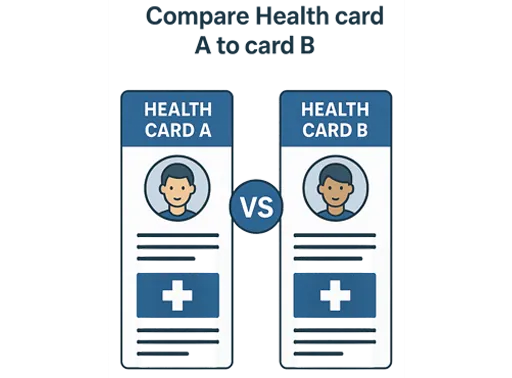Sub-Limits In Insurance




Simran is an insurance expert with more than 4 years of experience in the industry. An expert with previous experience in BFSI, Ed-tech, and insurance, she proactively helps her readers stay on par with all the latest Insurance industry developments.
Reviewed By:

Sharan Gurve has spent over 9 years in the insurance and finance industries to gather end-to-end knowledge in health and term insurance. His in-house skill development programs and interactive workshops have worked wonders in our B2C domain.
Updated on Jul 09, 2025 5 min read
What is a Sub-limit in Health Insurance Policy?
When planning to buy health insurance, certain factors must be considered to opt for the best possible coverage, such as waiting periods, deductibles, and co-payments. However, among all other essential factors, the sub-limit is the most underrated crucial factor in a health insurance policy.
A sub-limit is a pre-decided limitation on the claim amount per different conditions imposed on your health insurance policy by the insurer. Please note that these limits can be placed on hospital room rent, doctor’s consultation fee, ambulance charges, and treatment of certain diseases, such as cataract removal, knee ligament reconstruction, Etc.
To understand the concept of sub-limit in health insurance, keep reading the subtopics below:
Understand the Term Sub-limit for Insurance
The term sub-limits in health insurance is a condition that the insurance provider will pay the expenses of medical issues only up to a specific limit. However, sub-limits will be determined while purchasing a health insurance policy .
For instance
- Shivam and his wife Prachi bought a health insurance policy of INR 2 lakhs, each with similar perks.
- After one year, Shivam and his wife had an accident and needed to be hospitalized.
- Shivam knew his health insurance sub-limit was around 2,000 per day, so he opted for the room under the allowance.
- But Prachi is unaware of her rent allowance, so she opts for a room that costs INR 4,000 per day.
- However, during the bill settlement after 4 days of hospitalization, the insurer paid Shivam the entire three days of hospitalization room rent.
- But Prachi has to pay INR 8,000 extra from her pocket. After that, Prachi was disappointed and asked Shivam, what is sub-limit?
Health insurance providers impose sub-limits on certain conditions such as hospital rooms, rent, ambulances, or some pre-planned medical issues. So, it is necessary to check the list of ailments covered in the sub-limit cap and how much it’ll be.
Types of Sub-limits in Health Insurance
A sub-limit is split into three categories. Please note that the list of ailments and cap in treatment costs for various medical conditions may vary from one health insurer to another. Let’s take a look at the key pointers below to understand different types of sub-limits in health insurance.
1. The Ailments Specific Sub-limits
The ailments-specific sub-limits refer to the condition when the insurer sets a coverage limit on the medical expenses of specific diseases, such as cataract surgery, kidney stones, hernia, tonsils, piles, Etc. However, your sum insured amount may be higher, but you cannot claim your entire medical expenses due to the sub-limit clause on some medical practices.
For instance, the insurer has put a sub-limit of INR 60,000 on kidney stone surgery, but the surgery cost is INR 70,000. In that case, the insurer will pay INR 60,000 as per the limit decided, and the policyholders must pay the remaining balance.
It is necessary to check the list of diseases/ailments under the sub-limits clause and the coverage limit specified against each. It’ll help you to know the coverage limit based on a health plan and make an informed decision.
2. Hospital Room Rent Sub-limits
The hospital room rent sub-limits refer to the conditions when the insurer imposes a specific limit on room rent per day coverage. If policyholders opt for a hospital room that exceeds their sub-limit, then the insured person will pay the remaining balance.
However, some insurance providers offer sub-limits caps on room rent, and ICUs are 1% and 2% of the sum insured. It may vary depending on the different room packages.
For instance, if you hold an insurance policy with a sum insured of INR 6 lakhs, you can opt for a hospital room of INR 6,000 per day. In case the hospital room rent exceeds the sub-limit, then you need to pay for the remaining amount from your pocket.
3. Pre & Post-Hospitalization Sub-limits
It is important to note that some health insurance providers also offer sub-limits for pre & post-hospitalization expenses in their health plans. However, after critical surgeries or prolonged hospitalization, it may still require a patient to perform routine checkups after discharge. So, some insurers offer coverage for post-hospitalization expenses by imposing a sub-limit on medical expenses.
Pros and Cons of Sub-limit in Health Insurance
Pros of sub-limit in health insurance | Cons of sub-limit in health insurance |
|---|---|
| Sub-limits help to keep the premium of health policies low by imposing a sub-limit on certain conditions, and insurers can lower the overall policy cost. | When there is a sub-limit, it lessens the final claim amount. |
| Sub-limit assures policyholders how much they’ll get for specific types of treatment. | In case your claim exceeds the amount set out by the sub-limit, then you’ve to pay the remaining amount from your pocket. |
| Sub-limits are usually determined at the average rates most hospitals charge, offering policyholders peace of mind that they’ll not be exposed to any unexpected costs. | A policy with no sub-limits comes with higher premiums. |
| Health insurance plans with sub-limits can provide more limited coverage in the long run. | Since there is a limitation on some conditions, such as room rent, treatment of specific diseases, or post-hospitalization charges, policyholders can claim the amount set in a sub-limit. |
How Do Sub-Limits In Health Insurance Affect Your Claims?
When health insurance policies adopt sub-limits in health insurance policies, the final claim amounts are reduced. Since there are sub-limits on everything from room rent, ICU charges, ambulance charges, Certain ailments and treatments, pre and post-hospitalizations, and other such features insured individuals only file claims within the sub-limits making it easier to approve and provide medical care to customers without the chances of fraudulent claim filing.
What If Sub-limits are Mandatory?
While you can easily find an insurer that offers policies without sub-limits, it may cost you higher premiums. As we know, the sub-limits are pre-decided by the insurer, if you bought the policy with these clauses, you’d be unable to change claim amounts.
In case the sub-limit coverage offered in the policy does not fulfill your specific requirements or cost for healthcare, you can either increase the sum insured or opt for a different insurance provider.
Before making a final decision, look for a policy that fulfills your healthcare needs and fits your budget.
Conclusion
While buying health insurance, understanding sub-limits is quite essential because it can become a factor in determining whether or not a policy fits your requirements. However, comparing the sub-limits of different insurers while selecting the health insurance plan is essential to ensure a stress-free claim process during medical emergencies.
Consult for Personalized Insurance Advice

But how does it work?
Schedule a call with India’s number 1 trusted advisor with a 4.5+ rating on Google. We are not your average insurance agents. Our advisors are experts in their insurance knowledge and will give you the right information at the right time. The service is free of cost! Don’t worry, we won’t spam as we value your time.
Health Insurer Network Hospitals
Sub-Limits In Health Insurance: FAQs
1. What are sub-limits in Health Insurance?
Sub-Limits in health insurance are monetary capping or upper limits set by health insurance policies in order to avoid fraudulent claims and also provide ample amount of benefits to insured individuals as per their needs and requirements. These sub-limits are mentioned in the policy schedule on features like room rent., ICU charges, Ambulance Charges, and more.
2. Can I purchase health insurance without sub-limits?
Yes, there are multiple health insurance plans that do not apply sub-limits, and insured individuals can claim the amount up to actuals for all features and benefits mentioned in the policy schedule. In order to determine if the health insurance policy is ideal for you, it is advised to read the terms and conditions of a health insurance policy thoroughly.
3. Are sub-limits defined by IRDAI or the insurance providers?
No, sub-limits are pre-determined by insurance providers. It may vary from one plan to another. There are no separate guidelines or rules to set standard sub-limits for all health insurance plans by IRDAI.
4. Sub-limits in health insurance are applicable on both reimbursement and cashless claims?
Yes, sub-limits in health insurance are applicable on both reimbursement and cashless claims.
5. How do I cross-check sub-limits offered in a health insurance plan?
When purchasing health insurance plan check for sub-limits through the official brochure or product leaflet, or policy wordings provided on the official website of the insurance provider you approach.
6. What does the annual sub-limit mean?
Annual sub-limit refers to when the insurer pre-decides a certain amount you can claim on an insurance policy per year to treat certain conditions.
7. Is it mandatory to buy health insurance with sub-limits?
No, you can easily find an insurer that offers health plans without sub-limits, but it may cost you higher premiums.
8. Is the number of claims capped?
No, there is no limit on the number of claims that can be registered. You can keep making claims until the sum insured by the policy gets exhausted.
9. What if there is no sub-limit in health insurance?
If there is no sub-limit in health insurance, you can obtain coverage up to the sum insured limit.
10. Why do insurers put a sub-limit in health insurance policies?
Putting a sub-limit in health insurance policy prevents the policyholder from overspending on unnecessary medical services.
Health Insurance Companies
Know More About Health Insurance Companies

















